
Reisereise Skottland
Alt om Skottland
Attraksjoner Golfaktiviteter

South Street St Andrews
South Street is where you will find St Mary's Quad
and the Gregory meridian. The oldest part of the University
and the town gate (west port). Madras College Blackfriars Chapel ruins, the Town Hall and many other historic sites.
Vesthavnen
South Street St Andrews Skottland
West Port ble bygget rundt 1580 og er den eneste porten i sin opprinnelige posisjon igjen i Skottland. Det ser ikke ut til å være en del av en bymur som ville blitt stengt i tilfelle invasjon av engelskmennene. Porten ble omfattende pusset opp i 1843. Over midten av buen er St Andrews Coat of Arms


Gavin Douglas 1474 - 1522
Gavin Douglas ble født i Tantallon Castle East Lothian.
Han var tredje sønn av Archibald "Bell the Cat" Douglas 5. jarl av Angus. og hadde et hus i nærheten av dette stedet. En student ved St Andrews University, han var en poet kjent for sitt "Palice of Honour" og for hans "Eneados" en oversettelse av Virgils "Aeneid" til skotsk. Han var dekan for St. Giles Edinburgh i 1501 biskopen av Dunkeld i 1515. Døde 1522 London av pesten. Våpenskjoldet hans var en gang over plaketten, se nedenfor hvordan det så ut.

Madras College
South Street St Andrews
Madras College first opened in 1833 and takes its name from founder the Rev. Dr Andrew Bell and the educational system he devised.
see his plaque beside Blackfriars Chapel.

Blackfriars kapell


Blackfriars Chapel ble bygget i 1525 og skadet av brann i 1547 og ødelagt i 1559 av en protestant under reformasjonen. Strukturen på South Street er alt som gjenstår.
Charles Lapworth Plaque
South Street St Andrews
Charles Lapworth was a teacher at Madras College 1875 – 1881.
A self-taught Geologist was the founder of a new geological time (The Ordovician Period)
He became a Professor of Geology in 1881 at Birmingham University.
Plaque Reads:
CHARLES LAPWORTH, LLD, FRS, 1842-1920
Between 1875 and 1881 Lapworth was a teacher of English at Madras College. In his spare time he studied the Rocks of extinct creatures called Graptolites to help unravel the complexities of these ancient rocks. As a result of his careful studies, he proposed anew division of geological time, The Ordovician Period that is now recognised and used internationally. He also correctly interpreted the Moine Thrust Fault Zone in the North West Highlands of Scotland as amass of older rocks pushed over younger ones, an idea which at the time conflicted with orthodoxy. He left St Andrews in 1881 to become Professor of Geology at the University of Birmingham.

Dr Andrew Bell Plaque
South Street St Andrews
Dr Bell was born in South Street St Andrews in 1753
he died in 1832. Son of Bailie Bell, Andrew was Founder of the Madras College in 1833 he pioneered
the Madras System of Education.
Teaching system which went worldwide,
where older children taught younger children.
Plaque reads:
The Reverend Dr Andrew Bell 1753 – 1832
An educational reformer and philanthropist. He was born in
St Andrews. It was while serving in Madras in India that he developed a form of schooling where
the older pupils taught the younger.
When he returned he introduced his “Madras” or monitorial system as an economical form of mass education. The idea spread, Madras Schools appearing in Canada and Australia. Among the other local benefactions was the Bell fund for the benefit of St Andrews. He ended his career as Prebendary of Westminster Abbey. Where he is buried.

Dr John Adamsons hus


Dr John Adamson 1809 - 1870 bodde her 1845 - 1865
Han var lege og pionerfotograf.
I 1841 også han det første kalotypeportrettet.
Han lærte også broren Robert og Thomas Rodger teknikken og kunsten å fotografere.
Holy Trinity Church
South Street St Andrews
The Holy Trinity Church originally stood close to St Andrews Cathedral
and was built in 1144.
It has been in its present position in South Street since 1412.
Originally served by Roman Catholic priests
it changed with the Reformation in 1559
to Protestant and Episcopalian priests.
Since 1689 the ministers have been Presbyterian.
The Tower and two interior arches are the only original parts of the church from 1412 that remain.
1907 the church was demolished and rebuilt to the previous medieval church’s footprint and rededicated on St Andrews Day in 1909.

The Sharp Aisle
The Sharp Aisle, contains the tomb and monument to Archbishop Sharp (1618-1697),
Sharpe was murdered by Covenanters at Magus Muir 1697.
The Great East Window
Dated from 1910
The Good Physician
Dated from 1890 is the only surviving window prior to the reconstruction of the church in 1909.
John Knox Porch
In 1547 Holy Trinity was the scene of the first public sermon
of the famous reformer, John Knox.
He also preached in Holy Trinity in 1559, instructing residents of St Andrews to purge the city of "monuments of idolatry". Inspired by Knox's the local population rejected Catholicism, tore down statues and altars, and sacked St Andrews Cathedral.

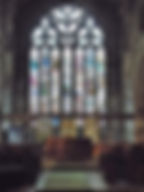
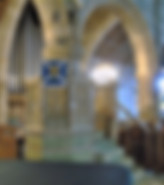
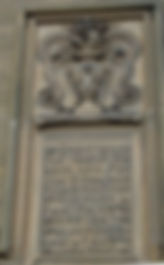
St Andrews rådhus
Queens Gardens
St Andrews
KY16 9TA
Skottland

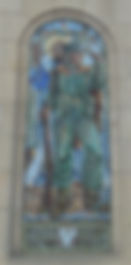
St Andrews rådhus reist i 1858 for kommunale og offentlige formål
Sir Hugh Playfair Provost.
Den polske soldaten St Andrews-minnesmerket
Robert Burns Club Plaque
South Street St Andrews
St Andrews Burns Club Plaque
Can be found on what was the Royal Hotel where the club was founded
on 25th January 1869.
13 in the Robert Burns World Federation
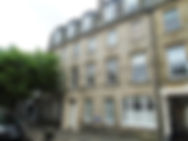


Hamish McHamish-statuen
Logies Lane
St Andrews
KY16 9NL
Skottland

Hamish McHamish var en ingefærkatt (15 år gammel) som bodde i St Andrews Skottland.
Han ble en internasjonal stjerne da en bok med tittelen Hamish McHamish of St Andrews: Cool Cat About Town ble publisert. Hamish en stjerne i sosiale medier med sin egen Facebook-side https://www.facebook.com/HamishMcHamishOfStAndrews og Twitter-konto @Hamish_McHamish. En nomadekatt som ble tatt vare på av mange av innbyggerne i St. Andrews. En gang eid av Marianne Baird.
Bailie Bell's House and Foundry
South Street St Andrews

In 1620 Edward Raban came to
St Andrews and set up a printing press in a building on the corner of North Street and Church Street.
This was later demolished by Bailie Bell in 1740 so he could build his house. This house is where his son was born in 1753 (Andrew). Andrew was to found Madras College and the "monitorial system" of education.
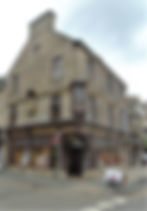
Royal Coat of Arms Tablet
South Street St Andrews
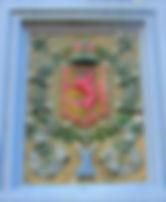
George Martine fra Claremont
George Martine av Claremont 1635 -1712
Bodde i South Street Han var en advokatkommissær i St. Andrews og forfatter av Erkebiskopsrådets første historie: "Reliquiae Divi Andreae"

George Martine FRS 1700 - 1741
George var en lege, kirurg og geolog, som senere bodde på 56 South Street. Han var den første som gjorde en nøye undersøkelse av varme og temperaturskalaer, og gjorde det første anslaget -400F, av den absolutte nulltemperaturen, Han laget det første nyttige kvikksølv i glass klinisk termometer. Her var i 1730 han utførte den første trakeotomien i Storbritannia
James David Forbes House
South Street St Andrews
James David Forbes was born in Edinburgh 20 April 1809
at 86 George Street.
He was educated at Edinburgh University in 1825. At 19, became a fellow of the Royal Society of Edinburgh, and in 1832
he was elected to the
Royal Society of London.
In 1859 he was appointed successor to David Brewster as principal of the United College of St Andrews, which he held until his death in 1868. It could be said he was first to study the heating of the earth.


James Boswell og Samuel Johnson
Dette er stedet for Glass Inn 29 South Street hvor Boswell og Dr. Johnson spiste kveldsmat den 18. august 1773.
Vi hadde en trist kjøretur i en mørk natt til St Andrews hvor vi ankom sent. Vi fant en god kveldsmat på Glass's Inn.
The Glass Inn overlevde rundt 1830

St. Andrews
Attraksjoner
St. Andrews katedral
The Pends
St. Andrews
KY16 9QL
Skottland
St. Andrews Castle
Poengene
St. Andrews
KY16 9AR
Skottland
Holy Trinity Church
St Mary's Places
St. Andrews
KY16 9UY
Skottland
Vesthavnen
South Street
St. Andrews
KY16 9EG
Skottland
Hamish McHamish -statuen
Logies Lane
St. Andrews
KY16 9NL
Skottland
Blackfriars kapell
Madras hus
South Street
St. Andrews
KY16 9EH
Skottland
Biskop Wardlaw -statuen
St. Marias firkant
St. Andrews
Skottland
Kingsbarns sognekirke
Hovedgate
Kingsbarns
St. Andrews
KY16 8SS
Skottland
St. Andrews rådhus
Queens Gardens
St. Andrews
KY16 9TA
Skottland
Tom Morris Grave
The Pends
St. Andrews
KY16 9RG
St Rules Tower
St. Andrews
KY16 9QZ
Bell Pettigrew -museet
Bute medisinske bygninger
Biologisk skole
Dronningens terrasse
St. Andrews
KY16 9TS
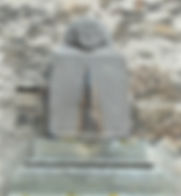
James Gregorys
Meridianlinjen
South Street St Andrews Skottland James Gregory var første regius professor i matematikk.
Han la en meridian i 1748. Han og to andre var grunnleggerne av kalkulus.
Han oppfant det gregorianske teleskopet For en mer dyptgående titt på Gregorys arbeid gå til


